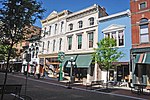Singing Bridge
1893 establishments in KentuckyBridges completed in 1893Bridges of the United States Numbered Highway SystemBridges over the Kentucky RiverHistoric district contributing properties in Kentucky ... and 6 more
National Register of Historic Places in Frankfort, KentuckyPennsylvania truss bridges in the United StatesRoad bridges on the National Register of Historic Places in KentuckyTransportation in Franklin County, KentuckyU.S. Route 60Use mdy dates from August 2023

The Singing Bridge (also known as the St. Clair Street bridge) is a two-lane vehicle and pedestrian bridge in Frankfort, Kentucky that is so named because of the humming sound it makes when driven over. As of 2019, the bridge carries over 5,000 vehicles per day across the Kentucky River along St. Clair Street to Bridge Street, joining Downtown Frankfort with South Frankfort. It is a contributing structure to the Frankfort Commercial Historic District on the National Register of Historic Places. The bridge gets its name from the humming noise it makes as vehicles travel across its open-grate steel deck, which replaced a solid flooring in 1937.
Excerpt from the Wikipedia article Singing Bridge (License: CC BY-SA 3.0, Authors, Images).Singing Bridge
Singing Bridge, Frankfort
Geographical coordinates (GPS) Address External links Nearby Places Show on map
Geographical coordinates (GPS)
| Latitude | Longitude |
|---|---|
| N 38.1965 ° | E -84.8788 ° |
Address
Singing Bridge
Singing Bridge
40601 Frankfort
Kentucky, United States
Open on Google Maps







